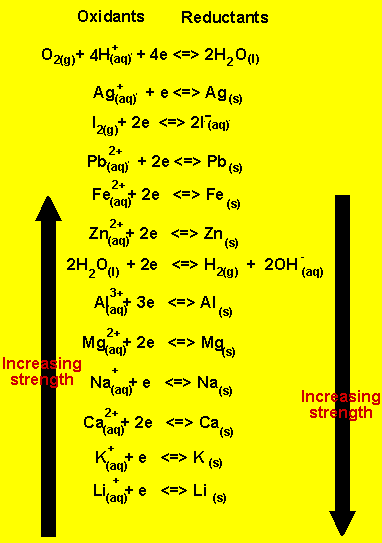Solution
An aqueous solution
of calcium nitrate is electrolysed.
a)What are the products
formed at the anode and at the cathode?
b) What happens to the pH of the solution?
In an electrolytic
cell, as well as in an electrochemical cell, the strongest oxidant will
react at teh cathode and the strongest reductant will react at the anode.
Looking the electrochemical series
we see that the oxidants present are water and calcium ions. Water is the
strongest oxidant present.
The only reductant present is water .
So at the cathode,
where reduction (electron usage) occurs, the reaction that will take place
is

So at the cathode hydrogen gas
and hydroxide ions are produced.
At the anode, where
oxidation occurs (electron loss), the reaction that will take place is

So at the anode oxygen gas and
hydrogen ions are produced.
The pH will remain
neutral as the number of hydroxide ions equals the number of hydrogen ions
produced per mole of electrons pumped through the circuit.
Click
to hide the solution
Solution
An aqueous solution of lead nitrate
is electrolysed.
a) What are the products formed
at the anode and at the cathode?
b) What happens to the pH of the solution?
In an electrolytic
cell, as well as in an electrochemical cell, the strongest oxidant will react
at teh cathode and the strongest reductant will react at the anode.
Looking the electrochemical series
we see that the oxidants present are water and lead(II) ions. Lead(II) ions
are the strongest oxidant present.
The only reductant present is water .
So at the cathode,
where reduction (electron usage) occurs, the reaction that will take place
is

At the anode, where
oxidation occurs (electron loss), the reaction that will take place is

So at the anode oxygen gas and hydrogen
ions are produced.
The pH will decrease
as the number of hydrogen ions produced steadily increase.
Click
to hide the solution
An aqueous solution containing
magnesium nitrate and zinc nitrate is electrolysed. Use the reactivity series
on the right.
a)What are the products formed
at the anode and at the cathode?
b) What happens to the pH of the solution?
In an electrolytic
cell, as well as in an electrochemical cell, the strongest oxidant will react
at teh cathode and the strongest reductant will react at the anode.
Looking the electrochemical series
we see that the oxidants present are water and magnesium(II) ions and zinc(II)
ions
Te Zinc(II) ion is the strongest oxidant present.
The only reductant present is water .
So at the cathode,
where reduction (electron usage) occurs, the reaction that will take place
is

So at the cathode hydrogen gas and
hydroxide ions are produced.
At the anode, where
oxidation occurs (electron loss), the reaction that will take place is

The pH will decrease
as the number of hydrogen ions produced steadily increase.
Click
to hide the solution
Solution
An aqueous solution containing
ammonium iodide and zinc nitrate is electrolysed. Use the reactivity series
on the right.
a)What are the products formed
at the anode and at the cathode?
b) What happens to the pH of the solution?
In an electrolytic
cell, as well as in an electrochemical cell, the strongest oxidant will react
at the cathode and the strongest reductant will react at the anode.
Looking at the electrochemical series
we see that the oxidants present are water and zinc(II) ions
The Zinc(II) ion is the strongest oxidant present.
The reductants present are water and
the iodide ion.
So at the cathode,
where reduction (electron usage) occurs, the reaction that will take place
is

At the anode, where
oxidation occurs (electron loss), the reaction that will take place is

So at the anode iodine gas is produced.
The pH will decrease
as the number of hydrogen ions produced steadily increase.
Click
to hide the solution
Electrolysis
in solutions exercises 2
|
1) An aqueous solution of
calcium nitrate is electrolysed. Use the reactivity series on the right.
a)What are the products formed
at the anode and at the cathode?
b) What happens to the pH of the solution?
Solution
2) An aqueous solution of
lead nitrate is electrolysed. Use the reactivity series on the right.
a)What are the products formed
at the anode and at the cathode?
b) What happens to the pH of the solution?
Solution
3) An aqueous solution containing
magnesium nitrate and zinc nitrate is electrolysed. Use the reactivity
series on the right.
a)What are the products formed
at the anode and at the cathode?
b) What happens to the pH of the solution?
Solution
4) An aqueous solution containing
ammonium iodide and zinc nitrate is electrolysed. Use the reactivity
series on the right.
a)What are the products formed
at the anode and at the cathode?
b) What happens to the pH of the solution?
Solution
|
 |
|
|
![]()
![]()
